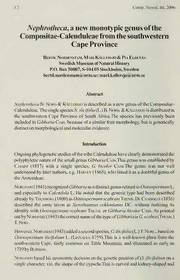
Nephrotheca, a new monotypic genus of the Compositae-Calenduleae from the southwestern Cape Province PDF
Preview Nephrotheca, a new monotypic genus of the Compositae-Calenduleae from the southwestern Cape Province
32 Comp. Newsl. 44, 2006 Nephrotheca^ a new monotypic genus ofthe Compositae-Calenduleae from thesouthwestern Cape Province BertilNordenstam,MariKallersjo&PiAEldenas SwedishMuseumofNaturalHistory P.O.Box50007,S-10405Stockholm,Sweden bertil.nordenstam(a)nrm.se;[email protected] Abstract NephrothecaB. Nord& Kallersjo is described as anew genus oftheCompositae- Calenduleae.ThesinglespeciesN. ilicifolia(L.)B.Nord.&Kallersjoisdistributedin the southwestern Cape Province ofSouth Africa.The species has previously been included in GibbariaCass. becauseofasimilarfruitmorphology, butisgenerically distinctonmorphologicalandmolecularevidence. Introduction OngoingphylogeneticstudiesofthetribeCalenduleaehaveclearlydemonstratedthe polyphyleticnatureofthesmallgenus GibbariaCASs.Thisgenuswasestablishedby Cassini (1817) with a single species, G. bicolor CASS.The genus was not well understoodby laterauthors, e.g. Harvey(1865),who listeditasadoubtful genusof theArctotideae. NoRLiNDH(1943)recognizedGibbariaasadistinctgenusrelatedtoOsteospermiimL. and especially to Calendula L. He noted that the generic type had been described alreadybyThunberg(1800)asOsteospermiimscabrumThunb.DeCandolle(1836) described the same taxon as Xerothammts eckloniamis DC. without realizing its identitywith Osteospermumscabrum Thunb. or Gibbaria bicolorCass.As pointed outbyNoRLiNDH(1943)thecorrectnameofthetypeoiGibbariaisGscabra(Thunb.) TNORL. However,Norlindh(1943)addedasecondspecies,G ilicifdlia(L.)T.Norl.,basedon Osteospermum ilicifolium L. (Linnaeus 1759).This is a well-known plant from the southwestern Cape, fairly common on Table Mountain, and illustrated as early as 1739byBuRMAN. Norlindh basedhistaxonomicdecisiononthegenericpositionofO. ilicifoliumona singlecharacter, viz. the shapeofthecypsela.This iscurvedandkidney-shapedand . Comp. Newsl. 44, 2006 33 alsoprovidedwithadistinctventralcavityinGibbariascabraaswellasO. ilicifolium (Fig.2). However,thesetwospeciesareverydifferentinotherimportantmorphologicalchar- acters(seebelow),andinouropiniontheyarenotcongeneric.Thisconclusionisalso supported by molecular information obtained from an ongoing study ofthe entire tribe (Kallersjo et al., in prep). Both species of Gibbaria were included in a phylogenetic analysisbasedonsequences fromthendhVandtmL-¥genes,together witharepresentivesampleofallrecognizedgenerasensuNordenstam(inpress).The analysis placed the two Gibbaria species in very different parts ofthe tree (Fig. 3). Gibbaria ilicifolia was found as sister to all Calenduleae save Ganileum and Dimorphotheca, whereas GibbariascabrawasnestedwithinagroupofOsteosper- mums,with OsteospermumglabrumN. E. Br. asitsclosestrelative.Toensurethatit was not a case of contamination we repeated the DNA extractions, PCR and sequencing, but the result was the same. Analyses using parsimony jackknifing & (Farrisetal. 1996)orBayesian inference(Huelsenbeck Ronquist2001)resulted completely congruent topologies. A new monotypic genus is here described to accommodate the southwestern Cape species Gibbaria ilicifolia. The generic name Nephrotheca is inspired by the reniformcypselas. & NephrothecaB.Nord. Kallersjo,gen.nov.(Compositae-Calenduleae) Frutex erectus vel difflisus ramosus usquead0.5 m altusglanduloso-hirtellus. Folia altema sessilia ovato-oblonga ad lanceolata 2-6 cm longa 1^ cm lata, apice mucronata, margine sinuato-dentata vel denticulata. Capitula solitaria breviter pedunculataheterogamaradiata.Involucrumcampanulatum;involucribracteae 10-13 uniseriataevelsubbiseriataelanceolatae6-10mmlongae 1.5-2.5mmlatae. Flosculi radii feminei 10-13; ligulae flavae subterplerumquerubro-violaceae. Flosculi disci 9-steriles,corollaflavaquinqelobata.Cypselaehomomorphaecalvaeglabraeincurvae reniformes4—5mmlongae2-3mmlataecavemamventralemincludentes. & Type:A^. ilicifolia(L.)B.Nord. Kallersjo. Singlespecies: & NephrothecaiUcifolia(L.)B.Nord. Kallersjo,comb.nov. Basionym:OsteospermumilicifoliumL.,Syst.Nat.ed. 10: 1234(1759). Lectotype,designatedhere:Herb.LINN 1037:9(LINN).-Fig. 1 N. ilicifoliaiswidespreadinthesouthwesternCapeProvinceincludingTableMoun- tain and other parts ofthe Cape Peninsula, and also on mountain slopes up to ca. 1000 ms.m.northwardstoBainsKloofandFrenchHoekMountainsandeastwards 34 Comp. Newsl. 44,2006 to Swellendam. It is a smelly glandular shrub or shrublet with flat oblong to ovate leaves with a dentate and scabrid margin. The solitary terminal capitula have phyllariesmoreorlessinasinglerow,yellowray-florets,sometimeswithareddishor purpletingebelow,andthedisc-floretsarealsoyellow. Thegenus GibbariaCass, isnow likewisemonotypic. G. scabraCass, is a shrublet withaverydifferenthabit,withentire,lineartosubulateandapicallypungentleaves; the involucral bracts are imbricate, and the rays are white above and more or less orange-yellowbelow. References BuRMAN, J. 1739. Rariorum africanarum plantarum, p. 172, tab. 62. Boussiere, Amsterdam. Candolle,a. p. de 1836.Prodromussystematisregnivegetabilisvol. 5.Treuttel& Wiirtz,Paris. Cassini,H. 1817.79.Gibbaria.Bull. Sci.Soc.Phil. 1817:139. & G Farris,J. S.,Albert,V.A., Kallersjo, M., Lipscomb,D., A. Kluge. 1996. Parsimonyjackknifingoutperformsneighbour-joining.Cladistics 12: 99-124. Harvey,W.H. 1865. Compositae.In:Harvey,W.H.&O.W.Sonder,Floracapensis vol.3.HodgesSmith&Co.,Dublin;Juta,CapeTown. Huelsenbeck, J. P. & F. RoNQUisT 2001. MrBAYES: Bayesian inference of phylogenetictrees.5/o/>7/orma//c5 17:754-755. Kallersjo,M.,Nordenstam,B.,Eldenas,P.,Barker,N.P.&A.R.Woodinprep. Are-evaluationofgenericdelimitationsintheCalenduleae-morphologicaland molecularevidence(tentativetitle). Linnaeus,C. 1759.Systemanaturae,ed. 10.Imp.L.Salvii,Holmiae. Nordenstam,B. inpress.TribeCalenduleae.In: Kadereit,J.W. &C.Jeffrey(eds.), TheFamiliesandGeneraofVascularPlants,vol.VIII(seriesed.,K.Kubitzki). Flowering plants. Dicotyledons. Asterales. Berlin, Heidelberg, New York: Springer. Norlindh, T. 1943. Studies in the Calenduleae. I. Monograph of the genera Dimorphotheca, Castalis, Osteospermum, Gibbaria and Chrysanthemoides. C.W.K.Gleerup,Lund. Thunberg, C. P. 1800. Prodromusplantarum capensium, pars posterior. Joh. Fr. Edman,Upsaliae. Comp. Newsl. 44, 2006 35 !€ i a:^.y^^- Fig. 1. LectotypeoWsteospermumilicifoUumL.,generictypeofNephrotheca B.NoRD.&Kallersjo.linn1037:9(LINN). ''ilicifoUum'"inLinnaeus'handwriting. 36 Comp. Newsl. 44, 2006 D Fig. 2. CypselasofNephrothecailiclfolia(L.) B.NoRD.&Kallersjo(A-C)andGibbahascabra(Thunb.)T.Norl.(D-F). A, DRadialside.B,EVentralside.C,FLongitudinalsectionshowingseed cavity(left)andventralcavity(right), x6.FromNorlindh(1943). < Comp. Newsl. 44, 2006 37 2 m —I ;-( cO3 O «9 03 C3 o 2 ex 0O-)h U C O O o eOn 0^3 _ —^ -^*— -4—" .D 1^ O < Oc3 Q Uc3 O O O o u Fig.3.SimplifiedparsimonyjackknifetreeshowingthepositionofNephrotheca inthetribe, basedonndh¥ and//77L-F sequencedata. Numbersonnodesrepresentparsimonyjackknifefrequencies.
